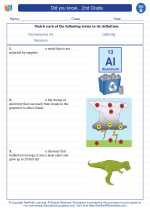Cnidarians
Cnidarians are a diverse group of animals that are found in marine environments. They are characterized by the presence of specialized stinging cells called cnidocytes, which they use for capturing prey and for defense. Cnidarians exhibit radial symmetry and have a simple body plan that includes a central mouth surrounded by tentacles.
Key Characteristics of Cnidarians:
- Radial Symmetry: Cnidarians exhibit radial symmetry, which means that their body parts are arranged around a central axis.
- Cnidocytes: These specialized cells contain nematocysts, which are used to inject toxins into prey or predators.
- Tentacles: Cnidarians have tentacles surrounding their mouths, which they use for capturing food.
- Two Body Forms: Cnidarians can exist in two body forms: the polyp and the medusa. The polyp form is cylindrical and attached to a substrate, while the medusa form is bell-shaped and free-swimming.
Types of Cnidarians:
There are several classes of cnidarians, including:
- Hydrozoa: This class includes species such as hydras and Portuguese man o' wars.
- Scyphozoa: These are the true jellyfish, with a dominant medusa form.
- Anthozoa: This class includes sea anemones, corals, and sea fans, which are primarily polyp forms.
- Cubozoa: Known as box jellyfish, these cnidarians have a cube-shaped medusa form.
Ecological Importance:
Cnidarians play important roles in marine ecosystems. Coral reefs, which are formed by the calcium carbonate skeletons of coral polyps, provide habitat for a wide variety of marine organisms. Additionally, cnidarians serve as a food source for many marine animals and contribute to the balance of marine food webs.
Study Guide for Cnidarians:
- What is the defining characteristic of cnidarians?
- Describe the two body forms of cnidarians.
- Name three classes of cnidarians and provide an example of a species from each class.
- Explain the ecological importance of cnidarians in marine ecosystems.
- How do cnidarians capture prey?
[Cnidarians] Related Worksheets and Study Guides:
.◂Science Worksheets and Study Guides Second Grade. Did you know... 2nd Grade
Study Guide Did you know... 2nd Grade
Did you know... 2nd Grade  Worksheet/Answer key
Worksheet/Answer key Did you know... 2nd Grade
Did you know... 2nd Grade  Worksheet/Answer key
Worksheet/Answer key Did you know... 2nd Grade
Did you know... 2nd Grade  Worksheet/Answer key
Worksheet/Answer key Did you know... 2nd Grade
Did you know... 2nd Grade  Vocabulary/Answer key
Vocabulary/Answer key Did you know... 2nd Grade
Did you know... 2nd Grade 

 Worksheet/Answer key
Worksheet/Answer key
 Worksheet/Answer key
Worksheet/Answer key
 Worksheet/Answer key
Worksheet/Answer key
 Vocabulary/Answer key
Vocabulary/Answer key

The resources above cover the following skills:
Earth Systems Science
Weather and the changing seasons impact the environment and organisms such as humans, plants, and other animals. Students can:
Analyze ways in which severe weather contributes to catastrophic events such as floods and forest fires